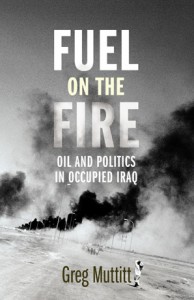Sami Ramadani reviews Fuel on the Fire: oil and politics in occupied Iraq , by Greg Muttitt
Red Pepper
August 2011
 In Fuel on the Fire, Greg Muttitt has meticulously and forensically examined official and oil industry documents to establish ‘beyond reasonable doubt’ that the Iraq war has the smell of crude oil emanating from many of its blood-soaked tentacles.
In Fuel on the Fire, Greg Muttitt has meticulously and forensically examined official and oil industry documents to establish ‘beyond reasonable doubt’ that the Iraq war has the smell of crude oil emanating from many of its blood-soaked tentacles.Greg and I have worked together in Naftana (Arabic for ‘our oil’), a committee to support the Iraqi oil workers union. And while others on the committee were much more absorbed in other ramifications of the occupation, Greg distinguished himself by pursuing the details of US-led plans to control Iraqi oil. The book is the product of that diligence, for which I think most Iraqis will give him a big thank you.
Significantly, the book has another important but understated merit. It highlights a key feature of the occupation: the deadly divide-and-rule tactics. With more than a million dead, and with the attempt to subdue the Iraqis devouring more lives and destroying more institutions, the war has become one of history’s major crimes. Central to this are the efforts to splinter Iraqi society along sectarian, ethnic and regional lines.
Greg has captured an aspect of Iraqi society that most mainstream writers and journalists have missed. Over many decades, most have fallen victim to the British colonialist dictum that the Iraqi people are deeply hostile to each other due to allegiance to their respective religion, sect, or ethnic group.
In reality, for most Iraqis their mosaic of backgrounds is a treasured asset, born of a long history of Mesopotamia as a land of riches and great civilisations that has experienced large-scale migrations, invasions and occupations.
Iraq has seen many rulers and ruling classes that resorted to ruthless methods of control, and its people came to realise through bitter experience that combating tyranny could only be effective through political unity. British colonial rule tried hard to destroy it, and despite backing modern sectarian political forces in Iraq it failed to drag most of the people into supporting these forces. Fuel on the Fire correctly observes that the US has also failed in this task.
In tapping into this Iraqi ‘psyche’, Greg Muttitt has identified and partly chronicled US tactics. The mantra of Shia against Sunni has been so persistent and beguiling it has not only dominated the mainstream discourse on Iraq but has crept into the work of many anti-war writers. It is so subliminal in its influence that even Greg occasionally slips into repeating sectarian myths, such as when he describes the nationalist resistance to the occupation as being ‘mostly Sunni’ and in blaming most of the sectarian killings on the Sadrists.
The reality is that most of the armed resistance to the occupation has been and still is in overwhelmingly Shia areas. This is rarely highlighted by the media, because it goes against the narrative that the occupation liberated the Shia from so-called Sunni control. Even BBC journalists have admitted that it was difficult for them to sleep at the British bases in the south due to the nightly shelling of the bases. The shelling was carried out by the Sadrists, and they are doing the same today against the US bases in the south, Baghdad and Diala. This is despite the ceasefire agreement, which in practice meant that the Sadrists appeased Grand Ayatollah Sistani by not publicly displaying their weapons. The fact that the resistance is more effective in some areas has more to do with their socio-political history and logistics than the degree of patriotism of the Shia or the Sunni.
In this respect, there is one salient fact that Greg does not highlight, even when citing the blowing up of the Shia sacred shrine in Samarra, a mostly Sunni city that has been the trusted custodian of the shrine for many centuries. Iraqis outside the ruling circles consistently blame the occupation for the sectarian killings. This ‘conspiracy theory’ is the anchor and main pillar of the Iraqi narrative about the occupation. For Iraqis it is ‘the Americans’ who had a hand in blowing up the shrine, and who turn a blind eye to al-Qaida style terrorism to ignite sectarian conflict.
Why would the US do that if the aim is to control Iraq and its oil? Faced with mounting resistance and to avoid a crushing defeat, the US generals and strategists had to resort to the murderous dirty tactics of the ‘Salvador Option’, ‘Operation Phoenix’, and the ‘Surge’.
One unfair criticism of the book is to ask it to delve into the other strategic reasons for the war, such as encircling Iran, becoming less dependent on Saudi oil, using Iraq as an important base in the Middle East within the context of protecting Israel, attacking Syria, and so on. Another is to accuse it of not analysing in depth Iraq’s complex socio‑political map, or the complex role of oil within the capitalist economy and the conflict between the big powers.
The book’s central aim is to dispel the Blair-Bush myth that control over oil had little to do with the Iraq war. In this, Greg has set the record straight, and has done so brilliantly.
No comments:
Post a Comment